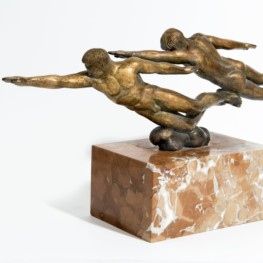Paul Manship
1885 - 1966
Bridging the gap between Modernists and Academicians, Paul Manship achieved early artistic fame by applying a streamlined, proto Art-Deco aesthetic to the classical and biblical subject matter of his bronze and marble sculptures. Born in 1855 in St. Paul, Minnesota, the sculptor initially studied painting at the St. Paul Institute of Art but subsequently shifted his focus to the modeling of three-dimensional forms upon the realization that he was afflicted by colorblindness. In 1905, he moved to New York and entered the Art Students League, soon thereafter serving as an assistant to Solon Borglum. This relationship, which lasted approximately two years, provided Manship with a solid knowledge of anatomical structures as well as practice in executing large-scale monuments.
After a stint at the Pennsylvania Academy of Fine Arts, where he studied life drawing with Charles Grafly, Manship went to work for Isidore Konti who encouraged him to compete for entry to the American Academy in Rome. Ultimately winning the prize for his relief sculpture Rest After Toil, the sculptor spent three years there observing the visible remnants of antiquity. Undoubtedly the most influential period of his life, Manship’s experience in Rome prompted his interest in re-interpreting cultural traditions, both Western and Eastern, into his own expressions of formal clarity and refined beauty.


